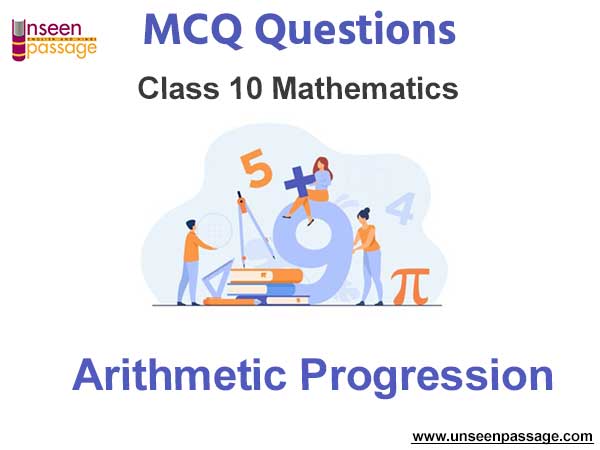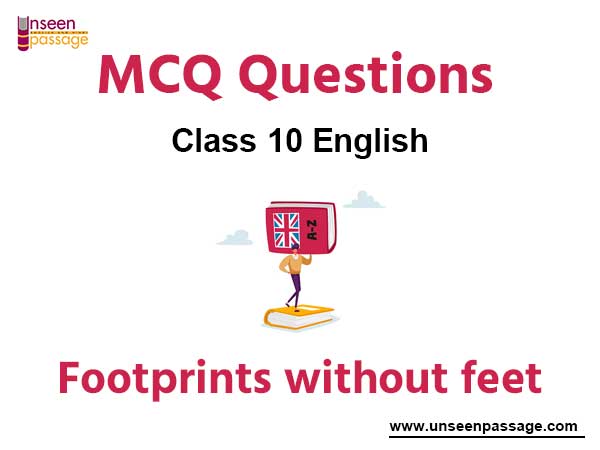Arithmetic Progression MCQ Class 10 Mathematics
Please refer to Chapter 5 Arithmetic Progression MCQ Class 10 Mathematics with answers below. These multiple-choice questions have been prepared based on the latest NCERT book for Class 10 Mathematics. Students should refer to MCQ Questions for Class 10 Mathematics with Answers to score more marks in Grade 10 Mathematics exams. Students should read the chapter Arithmetic Progression and then attempt the following objective questions.
MCQ Questions Class 10 Mathematics Chapter 5 Arithmetic Progression
The Arithmetic Progression MCQ Class 10 Mathematics provided below covers all important topics given in this chapter. These MCQs will help you to properly prepare for exams.
Question. The first term of an A.P. is 5 and its 100th term is –292. The 50th term of this A.P. will be
(a) 142
(b) –142
(c) 130
(d) –140
Answer
B
Question. If eight times the 8th term of an A.P. is equal to 12 times the 12th term of the A.P. then its 20th term will be
(a) –1
(b) 1
(c) 0
(d) 2
Answer
C
Question. If a, b, c are in A.P., then the value of (a + 2b – c) (2b + c – a) (c + a – b) will be
(a) 4abc
(b) 2abc
(c) abc
(d) None of these
Answer
A
Question. Given that the sum of the first ‘n’ terms of an arithmetic progression is 2n2 + 3n, find the 12th term.
(a) 72
(b) 36
(c) √625
(d) 56
Answer
A
Question. The common difference of the A.P. 1/P,1-P/P,1-2P/P, ……… is
(a) 1
(b) 1/ p
(c) –1
(d) − 1/ p
Answer
C
Question. First term of an arithmetic progression is 2. If the sum of its first five terms is equal to one-fourth of the sum of the next five terms, then the sum of its first 30 terms is
(a) 2670
(b) 2610
(c) –2520
(d) –2550
Answer
D
Question. The nth term of the A.P. a, 3a, 5a, ……., is
(a) na
(b) (2n – 1)a
(c) (2n + 1)a
(d) 2na
Answer
B
Question. If the sum of the series 2 + 5 + 8 + 11 ……….. is 60100, then the number of terms are
(a) 100
(b) 200
(c) 150
(d) 250
Answer
B
Question. In an A.P. if a = 5, an = 81 and Sn = 860, then n is
(a) 10
(b) 15
(c) 20
(d) 25
Answer
C
Question. If the nth term of an A.P. is given by an = 5n – 3, then the sum of first 10 terms is
(a) 225
(b) 245
(c) 255
(d) 270
Answer
B
Question. What is the value of k if (k + 2), (4k – 6) and (3k – 2) are three consecutive terms of an A.P.?
(a) k = –3
(b) k = 2
(c) k = –2
(d) k = 3
Answer
D
Question. What is the common difference of four terms in A.P. such that the ratio of the product of the first and fourth term to that of the second and third term is 2 : 3 and the sum of all four terms is 20 ?
(a) 3
(b) 1
(c) 4
(d) 2
Answer
D
Question. The 10th term of an AP is 20 and the 19th term is 101. Then, the third term is
(a) 43
(b) – 61
(c) – 52
(d) 1
Answer
A
Question. There are 60 terms in an A.P. of which the first term is 8 and the last term is 185. The 31st term is
(a) 56
(b) 94
(c) 85
(d) 98
Answer
D
Question. There are four arithmetic means between 2 and –18. The means are
(a) –4, –7, –10, –13
(b) 1, –4, –7, –10
(c) –2, –5, –9, –13
(d) –2, –6, –10, –14
Answer
D
Question. If the nth term of an A.P. is 4n + 1, then the common difference is :
(a) 3
(b) 4
(c) 5
(d) 6
Answer
B
Question. If a, b, c, d, e, f are in A.P., then e – c is equal to:
(a) 2(c – a)
(b) 2(d – c)
(c) 2(f – d)
(d) (d – c)
Answer
B
Question. If the sum of the first 2n terms of 2, 5, 8, ……. is equal to the sum of the first n terms of 57, 59, 61……., then n is equal to
(a) 10
(b) 12
(c) 11
(d) 13
Answer
C
Question. The sum of 11 terms of an A.P. whose middle term is 30, is
(a) 320
(b) 330
(c) 340
(d) 350
Answer
B
Question. The number of terms of the series 5, 7, 9, …. that must be taken in order to have the sum 1020 is
(a) 20
(b) 30
(c) 40
(d) 50
Answer
B
Question. The number of two digit numbers which are divisible by 3 is
(a) 33
(b) 31
(c) 30
(d) 29
Answer
C
Question. Suppose the sum of the first m terms of an arithmetic progression is n and the sum of its first n terms is m, where m ≠ n. Then, the sum of the first (m + n) terms of the arithmetic progression is
(a) 1 – mn
(b) mn – 5
(c) – (m + n)
(d) m + n
Answer
C
Question. The odd natural numbers have been divided in groups as (1, 3) ; (5,7, 9, 11) ; (13, 15, 17, 19, 21, 23), ….. Then the sum of numbers in the 10th group is
(a) 4000
(b) 4003
(c) 4007
(d) 4008
Answer
A
Question. If tn = 6n + 5, then tn+1 =
(a) 6(n + 1) + 17
(b) 6(n – 1) + 11
(c) 6n + 11
(d) 6n – 11
Answer
C
Question. If nth term of an AP is given by an = 2n + 3 then common difference of an AP is
(a) 2
(b) 3
(c) 5
(d) 1
Answer
A
Question. Which of the following represents an A.P. ?
(a) 0.2, 0.4, 0.6, ….
(b) 29, 58, 116….
(c) 15, 45, 135, 405…
(d) 3, 3.5, 4.5, 8.5 ….
Answer
A
Question. The value of x, for which 2x, x+ 10, 3x + 2 are three consecutive terms of an AP
(a) 6
(b) –6
(c) 18
(d) –18
Answer
A
Question. Sn = 54 + 51 + 48 + …….. n terms = 513. Least value of n is
(a) 18
(b) 19
(c) 15
(d) None of these
Answer
A
Question. Which of the following terms are in AP for the given situation
(a) 51,53,55….
(b) 51, 49, 47….
(c) –51, –53, –55….
(d) 51, 55, 59…
Answer
B
Question. The first and last term of an A.P. are a and l respectively. If S is the sum of all the terms of the A.P. and the common difference is l2-a 2/k- (l+a ) , then k is equal to
(a) S
(b) 2S
(c) 3S
(d) None of these
Answer
B
Question. If four numbers in A.P. are such that their sum is 50 and the greatest number is 4 times the least, then the numbers are
(a) 5, 10, 15, 20
(b) 4, 10, 16, 22
(c) 3, 7, 11, 15
(d) None of these
Answer
A
Question. Which of the following term is not in the AP of the above given situation
(a) 41
(b) 30
(c) 37
(d) 39
Answer
B
Question. Let Tr be the rth term of an A.P. for r = 1, 2, 3, …. If for some positive integers m, n we have, Tm =1/n and Tn =1/m , then Tmn equals
(a) 1/ mn
(b) 1/m+1/n
(c) 1
(d) 0
Answer
C
Question. What is the minimum number of days he needs to practice till his goal is achieved
(a) 10
(b) 12
(c) 11
(d) 9
Answer
C
Question. The number of common terms of the two sequences 17, 21, 25, ….., 417 and 16, 21, 26, …….., 466 is
(a) 19
(b) 20
(c) 21
(d) 91
Answer
B
Fill in the Blanks :
Question. The difference of corresponding terms of two A.P’s will be ……………….. .
Answer
another A.P.
Question. Sum of 1 + 3 + 5 + …. + 1999 is ……… .
Answer
1000/2 [2(1) (1000 1)2]
Question. 1, –1, –3, – 5, ……. , ……… .
Answer
–7, –9
Question. The sum of 8 A.Ms between 3 and 15 is ………………. .
Answer
72[8(3+15/2)etc.]
Question. The sum of n terms of an A.P. is 4n2 – n. The common difference = ……………… .
Answer
11 [S2 = 4(2)2 – 2 ⇒ 14, S1 = 4(1)2 – 1 ⇒ 3 etc.]
Question. 4, 10, 16, 22, …….., ………. .
Answer
28, 34
Question. 11th term from last term of an A.P. 10, 7, 4……… , – 62, is ……… .
Answer
–32
Question. In a flower bed, there are 23 rose plants in the first row, 21 in the second, 19 in the third, and so on. There are 5 rose plants in the last row. Number of rows in the flower bed is …………… .
Answer
n = 10
Question. Sum of all the integers between 100 and 1000 which are divisible by 7 is ………….
Answer
70336
True or False :
Question. If Sn of A.P. is 3n2 + 2n, then the first term of A.P. is 3.
Answer
False
Question. If an+1 – an = same for all ‘n’, then the given numbers form an A.P.
Answer
True
Question. 2, 4, 8, 16, …………. is not an A.P.
Answer
True
Question. 10th term of A.P. 2, 7, 12, ……… is 45.
Answer
False
Question. The balance money ( in ₹`) after paying 5% of the total loan of ` 1000 every month is 950, 900, 850, 800, . . . 50. represented A.P.
Answer
True
Question. The general form of an A.P. is a, a + d, a + 2d, a + 3d, ………….
Answer
True
Question. In an AP with first term a and common difference d, the nth term (or the general term) is given by an = a + (n – 1)d.
Answer
True
Question. If l is the last term of the finite AP, say the nth term, then the sum of all terms of the AP is given by : S= n/2(a +L)
Answer
True
Question. In an Arithmetic progression, the first term is denoted by ‘a’ and ‘d ’ is called the common difference.
Answer
True
Question. 301 is a term of A.P. 5, 11, 17, 23, …………. .
Answer
False

We hope you liked the above Arithmetic Progression MCQ Class 10 Mathematics. In case you have any questions please put them in the comments box below and our teachers will provide you a response.


